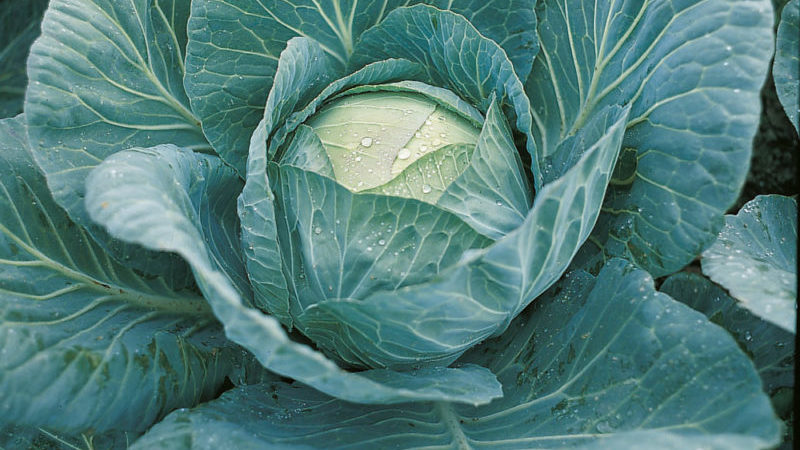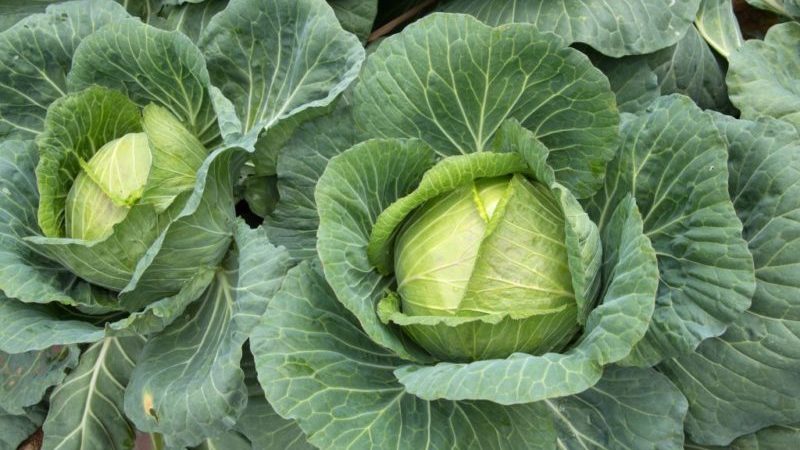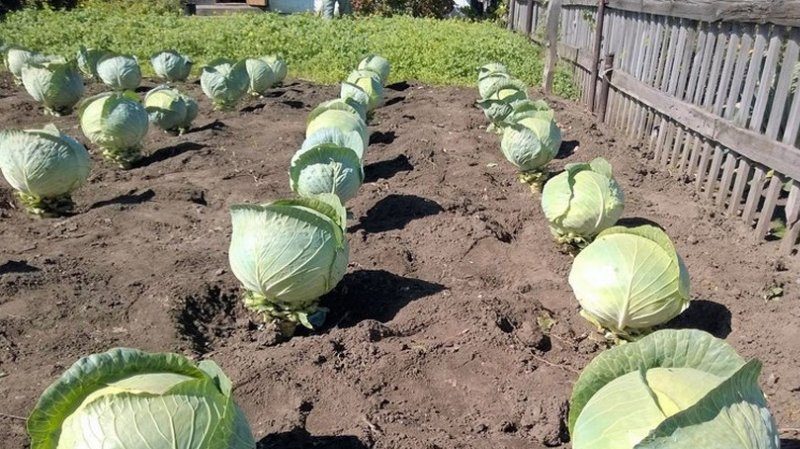An early ripe hybrid of Krautkaiser F1 cabbage, suitable for long-term storage
The name of the Krautkaiser f1 hybrid is translated as "cabbage king". This name is justified by the excellent marketability and taste of the heads of cabbage, the high yield of the hybrid, and its unpretentiousness to the climate and soil. The article will tell you in detail about the pros and cons of Krautkaiser cabbage, the requirements for care and the rules of agricultural technology.
The content of the article
What is this cabbage
Krautkayser is a hybrid of white cabbage, characterized by the ability to adapt to various climatic conditions and any type of soil.
The crop is harvested in September, digging the cabbage with a shovel. After that, the heads of cabbage, which do not have any damage or signs of disease, are dried under a canopy, wrapped in cling film, placed in wooden or plastic boxes and cleaned in a well-ventilated room with a temperature of 0 ... + 3 ° C and an air humidity of 80-90%. Under these conditions, the vegetable is stored for 4-7 months.

History of origin and distribution
The Krautkayser hybrid was developed in Holland by breeders of the agricultural company Bejo Zaden B.V.
Included in the state register of Russia in 1993 with admission to cultivation in the North, North-West, Central, Volgo-Vyatka, Nizhnevolzhsky, Ural, West Siberian, Far East and East Siberian regions.
Feature and Description
This is a hybrid of medium late ripening - from the moment of emergence to the ripening of the crop, 127-161 days pass. Marketable yield averages 574-1055 c / ha.
Reference. The maximum yield was recorded in the Krasnoyarsk Territory - 1284 c / ha.
Appearance and taste
It is a powerful, non-lying plant with a low-leafed, compact, raised leaf rosette. Leaves with smooth edges and slightly wrinkled surface, medium in size, obovate and slightly concave, colored blue-green and covered with a waxy coating of medium to strong intensity.
Heads of cabbage are oval or flat-rounded, leveled, partially covered, dense, white in section. They weigh an average of 3.2-4.8 kg, some specimens grow up to 6.5 kg. The outer stump is short, the inner stump is of medium length.
Reference. Due to the rapid growth, heads of cabbage weighing about 2.5 kg are removed already 100 days after germination.
The cabbage is juicy, sweetish in taste.

Resistant to temperatures
Hardened seedlings tolerate a short drop in air temperature to -2 ... -4 ° C, adult plants withstand frosts down to -4 ... -6 ° C.
Moisture and drought resistance
This is a moisture-loving culture - with a lack of moisture, heads of cabbage grow small and loose. At the same time, excessive watering and waterlogging of the soil lead to rotting of the root system and the death of plants. The optimum level of soil moisture is 80%.
Read also:
Disease and pest resistance
Krautkayser is relatively resistant to gray and white rot, vascular and mucous bacteriosis, fusarium wilt, and pinpoint necrosis.
With improper care and constant temperature extremes, the hybrid can be affected by keels and downy mildew.
Among pests, fleas, aphids and cabbage flies are dangerous.
Scope of this cabbage hybrid
Krautkayser cabbage is consumed fresh, added to salads and hot dishes, pickled and fermented.
Reference. Due to the high concentration of vitamin C, Krautkaiser leaves are used in folk medicine for the prevention and treatment of colds.
Advantages and disadvantages
The main advantages of the hybrid:
- friendly formation of the crop;

- large-fruited;
- unpretentiousness to the soil composition;
- the ability to adapt to various weather conditions;
- high productivity;
- good marketability and excellent taste of heads of cabbage;
- transportability and keeping quality;
- long-term (4-7 months or more) storage;
- no tendency to cracking.
Disadvantages of Krautkayser cabbage:
- medium degree of frost resistance;
- low resistance to a number of diseases;
- exactingness to watering.
Growing technology
When planting Krautkaiser cabbage, you need to correctly select and prepare the site and planting material, observe the sowing time and provide the culture with proper care.
Optimal conditions
Despite its unpretentiousness to the composition of the soil, Krautkaiser prefers nutritious, light, loose soil with a medium or neutral level of acidity.
The best option is loam or black soil. The site is loosened in the fall, dug up on a shovel bayonet, fed with mineral fertilizers, humus or compost.
The landing site should be sunny, open, protected from drafts and cold winds. The best predecessors are legumes, cucumbers and potatoes.
Important! You cannot plant cabbage in the lowlands - stagnant moisture leads to decay of the root system.
Before sowing, the seeds are wrapped in cheesecloth for 20-25 minutes. immersed in a warm (+ 45 ... + 50 ° C), and then for 2-3 minutes. into cold water. After that, the planting material is soaked for 12 hours in a growth stimulant solution (Kornevin, Epin), after swelling, it is wrapped again in gauze and put into the refrigerator overnight. For 2-3 days, the seeds are kept at room temperature during the day and put in the cold at night.
For growing seedlings, a substrate is used, consisting of equal parts of humus and sod land with the addition of wood ash. For disinfection, it is calcined in the oven for half an hour in advance at a temperature of + 180 ° C or spilled with a pale pink solution of potassium permanganate.
Terms and rules of landing
Seeds for seedlings are sown in mid-April... The prepared substrate is poured into a container with a layer of 7-8 cm, 1-1.5 cm deep grooves are made on the surface, seeds are placed in them, covered with soil on top and abundantly watered with a spray bottle.
The container is covered with polyethylene and placed in a bright place at a temperature of + 18 ... + 23 ° C. After 5-7 days, when shoots appear, the shelter is removed and for 13-15 hours the seedlings are transferred to a cooler place with a temperature of + 15 ... + 19 ° C.
When two full-fledged leaves are formed on the seedlings, the seedlings dive, burying the cotyledon leaves into the soil.
15 days before transplanting seedlings into the ground, they begin to harden. For this, containers with seedlings are daily taken out into the street or balcony, first for 5-6 hours, gradually increasing this time.
30-35 days after sowing the seeds, the seedlings are planted in open ground. Depending on the climate of the region, this time falls on the beginning, middle or end of May.
Landing rules:
- Form rows in the prepared area at a distance of 50-60 cm from each other.
- Every 40-50 cm, dig out the landing grooves in them.
- Water them abundantly with settled warm (+ 18… + 20 ° C) water.
- Remove the seedlings from the container along with a clod of earth and place in the holes.
- Cover the plants with nutritious soil, water abundantly.
The optimal planting density of Krautkaiser is 30-35 thousand per 1 ha.
Further care

Within 2-3 weeks after transplanting seedlings into the ground, it is watered 2-3 times a week. Then watering is carried out once every five days, in case of hot and dry weather - every three days.
The soil must be constantly moistened by at least 80% - this is necessary for the formation of large heads of cabbage. During the ripening of the heads, watering is stopped to avoid cracking.
The soil is loosened weekly. For the first time to a depth of 4-5 cm, then 7-8 cm. This improves the access of oxygen and moisture to the roots, enriches the soil with nutrients, activates the growth of greenery and avoids the formation of a dry crust on the soil surface.
The cabbage is spud twice a season - after the formation of small heads and 2-3 weeks after that. The procedure is carried out after rain or watering, raking the soil to the trunk to the level of the first full leaves. At the same time, the earth in the aisles is sprinkled with wood ash.
Reference. The Krautkaiser is able to suppress weed growth, which keeps weeding to a minimum.
Fertilizers are applied at least twice a season:
- 15 days after transplanting seedlings - ammonium nitrate solution (10 g per 10 L of water);
- the period of tying heads of cabbage - 8 g of potassium sulfate, 5 g of double superphosphate and 4 g of urea, diluted in 10 liters of water.
Possible problems, diseases, pests
Cabbage can be hit by:
- keela - a fungal disease that affects the roots of plants due to which growths appear on them;
- peronosporosis (downy mildew) - white spots appear on the underside of cabbage leaves, which eventually spread over the entire surface of the leaf plates.
For the prevention of diseases, the soil at the site is lime, regularly loosened and weeded, the level of moisture in the soil is monitored and treated with fungicidal preparations - "Fitosporin", "Oxyhom", "Abiga-Peak".
Dangerous pests for Krautkaiser are fleas, aphids and cabbage flies. To get rid of insects, plantings are treated with ash broth and insecticides, for example, "Bazudin", "Iskra-M", "Senpai", "Fufanon", "Inta-Vir".
Features of growing this hybrid, depending on the region
The requirements that Krautkaiser cabbage makes for cultivation and care do not radically change depending on the climatic conditions of the region. Only the timing of transplanting seedlings into open ground differs, therefore, they are guided by weather conditions - there should be no risk of recurrent night frosts, and the minimum permissible soil temperature is + 5 ... + 7 ° C.
Also, the frequency of watering plants depends on the weather - the hotter and drier the weather, the more often irrigation is carried out.
Reviews of summer residents
On specialized forums, gardeners speak positively about the Krautkaiser hybrid:
Vladimir, Voronezh: “For pickling and pickling, I always plant three varieties of cabbage: Krautkayser, Atria and Krautman. I like everything, but Krautkayser will win by being undemanding to the soil, and even fighting weeds, there is practically no need to weed the soil. I can't say anything about storage, because I always process the crop right away - no one in our family eats raw cabbage. But I think that the heads of cabbage will definitely lie in the cellar for six months ”.
Valentina, Bryansk: "Krautkaiser was planted for the first time last year and compared to other varieties that I have grown before, it showed itself just fine. The yield is high, the heads of cabbage are very beautiful, juicy and sweet. At the same time, I cannot say that it is difficult to care for this cabbage, in general, everything is as usual. I tried to ferment several heads of cabbage - I liked the result. Now I will plant more Krautkaiser so that there is enough for pickling and pickling. "
Marina, Krasnoyarsk: “I have no pretensions to Krautkaiser - the harvest is rich, the heads of cabbage are large, dense and sweet, they ripen together. If I looked for shortcomings, I would have noted that the cabbage is very "loose" and takes up a lot of space on the site. "
Read also:
Conclusion
Krautkaiser f1 is one of the best medium late white cabbage hybrids.It is characterized by unpretentiousness to care, climatic conditions and soil composition, high yield and large heads of cabbage with juiciness and pleasant sweet taste. The harvest is well stored, and the heads of cabbage are suitable for universal use.